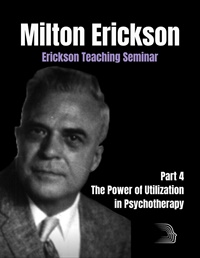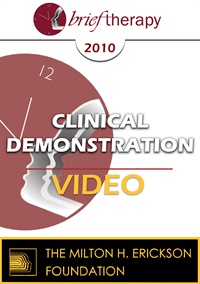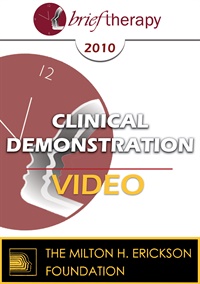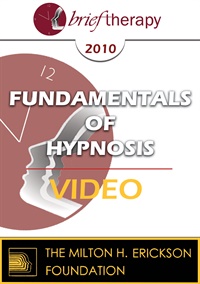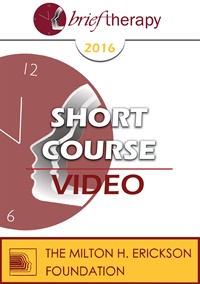- Average Rating:
- Not yet rated
- Topic Areas:
- Milton Erickson | Utilization | Ericksonian Psychotherapy | Psychotherapy | Ericksonian Hypnosis and Therapy Techniques | Hypnosis
- Categories:
- Erickson Materials | Erickson Streaming Video Collection | Milton H. Erickson Collections
- Faculty:
- Jeffrey Zeig, PhD | Milton H. Erickson, MD
- Course Levels:
- Master Degree or Higher in Health-Related Field
- Duration:
- 1 hour
- Format:
- Audio and Video
- Original Program Date:
- Jul 22, 2020
- Short Description:
- Join Milton Erickson at his teaching seminar in the late 1970s. You will encounter his innovative teaching methods prompting students to activate their utilization skills. Learn Erickson's process for creating memorable interventions with clients overly concerned about body image. Encounter his method of using nonverbal methods to evoke adaptive responses. Introduction and annotations by Jeff Zeig, Erickson Foundation Director.
- Price:
- $29.95 - Base Price
- Average Rating:
- Not yet rated
- Topic Areas:
- Hypnosis | Advanced Techniques of Hypnosis & Therapy | Ericksonian Hypnosis and Therapy Techniques | Marriage | Milton Erickson | Seeding | Utilization
- Categories:
- Advanced Techniques of Hypnosis & Therapy | Training | Milton H. Erickson Collections | World Languages | German
- Faculty:
- Milton H. Erickson, MD | Jeffrey Zeig, PhD
- Course Levels:
- Master Degree or Higher in Health-Related Field
- Duration:
- 2 Hours 24 Min
- Format:
- Audio and Video
- Original Program Date:
- Dec 31, 1977
- Short Description:
- This hypnotherapeutic session took place in 1978, and decades later, it’s just as powerful and engaging. Enhancing the viewer’s learning experience is Dr. Zeig’s discussion of the underlying elements of Erickson’s methods: the ARE model of instruction; the art of parallel communication; targeted utilization; and the use of implication. Erickson’s fluid repertoire, drawn from systematic thinking, includes the use of anecdotes, symbolic communication, and strategic seeding. The elicitation of solutions, based on promoting constructive associations and flexible thoughts and feelings, is an area of particular interest and one in which Erickson was especially elegant.
- Price:
- $65.00 - Base Price

- Average Rating:
- Not yet rated
- Topic Areas:
- Utilization | Clinical Demonstrations | Psychotherapy | Therapist Development | Anxiety | Ericksonian Hypnosis and Therapy Techniques | Religion | Art of Psychotherapy
- Bundle(s):
- Art of Psychotherapy - Utilization Series
- Categories:
- Art of Psychotherapy
- Faculty:
- Jeffrey Zeig, PhD
- Course Levels:
- Master Degree or Higher in Health-Related Field
- Duration:
- 2 Hours 22 Minutes
- Format:
- Audio and Video
- Original Program Date:
- Jun 21, 2020
- Short Description:
- In our first session, our demonstration subject has recently made a major life change. They have decided to change their career from being a priest, into becoming a therapist. Big life changes like these often induce anxiety in patients, and in this clinical demonstration we see Dr. Jeffrey Zeig exhibit a number of Ericksonian techniques to help the client be in harmony with themselves. Dr. Zeig utilizes some of Ginny’s religious history to help guide her towards transformation.
- Price:
- $79.00 - Base Price

- Average Rating:
- Not yet rated
- Topic Areas:
- Utilization | Clinical Demonstrations | Psychotherapy | Therapist Development | Children and Adolescent Therapy | Interviewing | Relationships | Therapeutic Relationship
- Bundle(s):
- Art of Psychotherapy - Utilization Series
- Categories:
- Art of Psychotherapy
- Faculty:
- Jeffrey Zeig, PhD
- Course Levels:
- Master Degree or Higher in Health-Related Field
- Duration:
- 2 Hours 18 Minutes
- Format:
- Audio and Video
- Original Program Date:
- Jun 28, 2020
- Short Description:
- Demonstration subject Mette is struggling with issues trying to feel an emotional connection to her children. She describes her difficulty with being present for her children, and is looking for guidance. Dr. Zeig exhibits a few simple techniques that help create a powerful therapeutic relationship quickly, through the use of gestures and strategic interview questions. Dr. Zeig is able to utilize this information to create useful suggestions to help Mette with her situation.
- Price:
- $79.00 - Base Price

- Average Rating:
- Not yet rated
- Topic Areas:
- Utilization | Clinical Demonstrations | Psychotherapy | Therapist Development | Age Regression | Language of Hypnosis | Therapeutic Relationship
- Bundle(s):
- Art of Psychotherapy - Utilization Series
- Categories:
- Art of Psychotherapy
- Faculty:
- Jeffrey Zeig, PhD
- Course Levels:
- Master Degree or Higher in Health-Related Field
- Duration:
- 2 Hours 15 Minutes
- Format:
- Audio and Video
- Original Program Date:
- Jul 05, 2020
- Short Description:
- Our demonstration subject for session three has two presenting issues - an undercurrent of sadness that seems to be everpresent, and a difficulty communicating about financial situations in her life. Dr. Zeig starts off the session by speaking Spanish, Karina’s native language. This simple technique puts Karina quickly at ease and sets the tone for the session. By inducing a hypnotic state Dr Zeig is able to do a quick age regression, and through utilizing a number of linguistic techniques - recursion, speaking in triplicate, altering tempo and tone of voice - he was able to seed therapeutic goals and create motivation for change.
- Price:
- $79.00 - Base Price

- Average Rating:
- Not yet rated
- Topic Areas:
- Utilization | Clinical Demonstrations | Psychotherapy | Therapist Development | Intimacy | Psychosomatics | Communication
- Bundle(s):
- Art of Psychotherapy - Utilization Series
- Categories:
- Art of Psychotherapy
- Faculty:
- Jeffrey Zeig, PhD
- Course Levels:
- Master Degree or Higher in Health-Related Field
- Duration:
- 2 Hours 22 Minutes
- Format:
- Audio and Video
- Original Program Date:
- Jul 12, 2020
- Short Description:
- For the final class in the Utilization series, Patricia joins us to discuss her preference for being in control, and how that relates to her struggles with intimacy. She also requests help alleviating a psychosomatic response from an earlier trauma. Dr. Zeig uses an interpersonal approach to this session, utilizing verbal and body language techniques to help communicate complex concepts. Zeig establishes the theme of appreciate as the through-line for this session.
- Price:
- $79.00 - Base Price
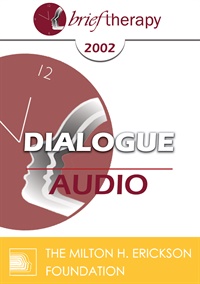
- Average Rating:
- Not yet rated
- Topic Areas:
- Dialogues | Utilization | Brief Therapy | Ericksonian Hypnosis and Therapy Techniques
- Categories:
- Brief Therapy Conference | Brief Therapy Conference 2002
- Faculty:
- Steve De Shazer, MSSW | Betty Alice Erickson, MS, LPC, LMFT
- Duration:
- 58:56
- Format:
- Audio Only
- Original Program Date:
- Dec 13, 2002
- Short Description:
- BT02 Dialogue 04 - Utilization - Steve de Shazer, MSSW and Betty Alice Erickson, MS, LPC, LMFT
- Price:
- $15.00 - Base Price
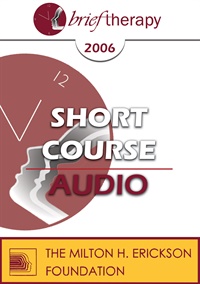
- Average Rating:
- Not yet rated
- Topic Areas:
- Short Courses | Addiction | Brief Therapy | Communication | Mind-Body | Utilization
- Categories:
- Brief Therapy Conference | Brief Therapy Conference 2006
- Faculty:
- Bart Walsh, MSW
- Duration:
- 1:19:30
- Format:
- Audio Only
- Original Program Date:
- Dec 07, 2006
- Short Description:
- This presentation poses a brief substance abuse treatment which acknowledges and accommodates the personal needs being addressed by substance use, bypasses perceived resistance and employs the essence of idiosyncratic psychobiological learning to achieve a body-mind gestalt complementary to the client's sobriety. Client self-empowerment and relapse prevention are built into the intervention. This method develops a safe framework for addressing any subsequent mental health themes directly or indirectly related to substance misuse. A particular form of body language known as ideomotor signaling is established in this procedure.
- Price:
- $15.00 - Base Price
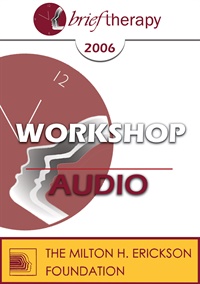
- Average Rating:
- Not yet rated
- Topic Areas:
- Workshops | Brief Therapy | Ericksonian Hypnosis and Therapy Techniques | Resources | Self-Relations | Utilization | Solution Oriented Approach
- Categories:
- Brief Therapy Conference | Brief Therapy Conference 2006
- Faculty:
- Stephen Gilligan, PhD
- Duration:
- 2:37:46
- Format:
- Audio Only
- Original Program Date:
- Dec 09, 2006
- Short Description:
- A key idea in Milton Erickson's work was that a person's problematic experiences and behaviors can be skillfully accepted and utilized as the basis for therapeutic change. Self-relations psychotherapy develops this idea further, emphasizing symptoms as indicating the death of an old identity and the impending birth of a new identity. Thus, we don't try to "get rid of" depression, anxiety, or "acting out/acting in" expressions, but instead invite them into a human relationship of "sponsorship", where their healing and helpful nature may be realized. We will see how a therapist can generate a ritual space where symptoms and other disturbing experiences can be "midwifed" into new identities.
- Price:
- $15.00 - Base Price
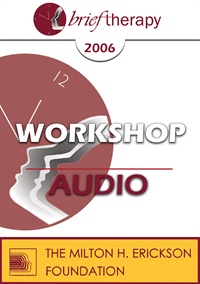
- Average Rating:
- Not yet rated
- Topic Areas:
- Workshops | Brief Therapy | Ericksonian Hypnosis and Therapy Techniques | Footprinting | Goals of the Therapist | Reframing | Utilization
- Categories:
- Brief Therapy Conference | Brief Therapy Conference 2006
- Faculty:
- Stephen Lankton, MSW
- Duration:
- 1:44:18
- Format:
- Audio Only
- Original Program Date:
- Dec 09, 2006
- Short Description:
- The Basic Foot Print is a process model of change in therapy that represents and identifies Erickson's method for change. It is a general umbrella under which we should be able to place any step of change or intervention. Encounters that follow the Basic Foot Print create change and any therapy that steps through these stages reflects Dr. Erickson's approach and echoes his legacy. The steps are: matching/connecting, blending, utilizing, introducing ambiguity (disrupting stasis), reframing and co-creating outcomes. An in-depth understanding of steps within the Basic Footprint will be taught, demonstrated and practiced.
- Price:
- $15.00 - Base Price
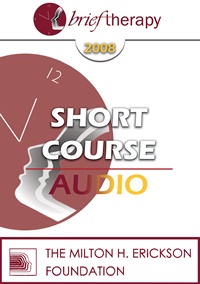
- Average Rating:
- Not yet rated
- Topic Areas:
- Short Courses | Addiction | Brief Therapy | Communication | Mind-Body | Utilization
- Categories:
- Brief Therapy Conference | Brief Therapy Conference 2008
- Faculty:
- Bart Walsh, MSW
- Duration:
- 1:24:25
- Format:
- Audio Only
- Original Program Date:
- Dec 11, 2008
- Short Description:
- This presentation poses a substance abuse treatment which acknowledges and accommodates the personal needs being addressed by substance use, bypasses perceived resistance and employs idiosyncratic psycho-biological learning to achieve a body-mind Gestalt complementary to the client's sobriety. Client self-empowerment and relapse prevention are built into the intervention. This method develops a safe framework for addressing any subsequent mental health themes directly or indirectly related to substance misuse. A simple form of bodymind communication, known as ideomotor questioning, is employed in this procedure. Because this is a new strategy, fundamental information applicable to all levels of professional experience, will be provided.
- Price:
- $15.00 - Base Price
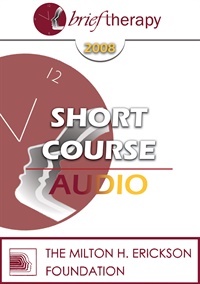
- Average Rating:
- Not yet rated
- Topic Areas:
- Short Courses | Utilization | Children and Adolescent Therapy | Seeding | Brief Therapy | Positive Psychology | Psychology
- Categories:
- Brief Therapy Conference | Brief Therapy Conference 2008
- Faculty:
- Peg LeBlanc, MA
- Duration:
- 1:27:10
- Format:
- Audio Only
- Original Program Date:
- Dec 11, 2008
- Short Description:
- The suggestibility of children provides an opportunity to build the strengths for lifelong mental resiliency. We will explore clinical practices based on research from brief strategic approaches, positive psychology, and the study of resiliency which suggest that long term mental health can be promoted through specific therapeutic approaches in treating children.
- Price:
- $15.00 - Base Price
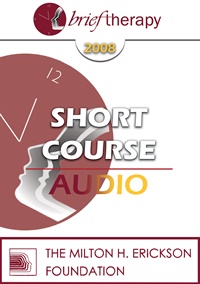
- Average Rating:
- Not yet rated
- Topic Areas:
- Short Courses | Memory | Psychotherapy | Utilization | Brief Therapy
- Categories:
- Brief Therapy Conference | Brief Therapy Conference 2008
- Faculty:
- Joseph Meyerson, MA
- Duration:
- 47:01
- Format:
- Audio Only
- Original Program Date:
- Dec 11, 2008
- Short Description:
- The possibility of utilizing memory plasticity for therapeutic purposes has not been widely recognized, although a number of theoretical and clinical venues during the past century have shown its potential application. This short course is aimed at shedding light on this broad field of hypnotherapeutic interventions and to present a primary map for the clinician interested in the psychotherapeutic implementation of MFI.
- Price:
- $15.00 - Base Price
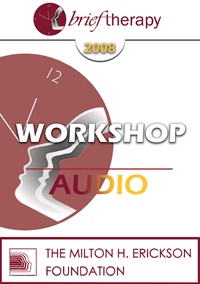
- Average Rating:
- Not yet rated
- Topic Areas:
- Workshops | Utilization | Brief Therapy | Self-Image Thinking | Resources
- Categories:
- Brief Therapy Conference | Brief Therapy Conference 2008
- Faculty:
- Stephen Lankton, MSW
- Duration:
- 2:19:24
- Format:
- Audio Only
- Original Program Date:
- Dec 11, 2008
- Short Description:
- Three specific techniques are universally valuable in brief therapy: utilization, experience resource retrieval, experiential-based imagery rehearsal. This workshop provides an exposure to these concepts and techniques with clear examples and demonstrations. Participants should find numerous ways to enhance their brief therapy practice in any setting and with all populations of clients.To list the essential aspects of the utilization approach for reducing resistance across multiple settings.
- Price:
- $15.00 - Base Price
- Average Rating:
- Not yet rated
- Topic Areas:
- Clinical Demonstrations | Trance | Utilization | Generative Psychotherapy | Somatic Experiences | Ericksonian Hypnosis and Therapy Techniques | Brief Therapy
- Categories:
- Brief Therapy Conference | Brief Therapy Conference 2010
- Faculty:
- Stephen Gilligan, PhD
- Course Levels:
- Master Degree or Higher in Health-Related Field
- Duration:
- 50:14
- Format:
- Audio and Video
- Original Program Date:
- Dec 11, 2010
- Short Description:
- This session will illustrate the Ericksonian utilization principle, which states that under proper conditions, a problem may easily transform into a solution. The demonstration will show how to develop such conditions via the experience of “generative trance,” such that positive shifts in a person’s somatic, cognitive and field experience lead to positive changes.
- Price:
-
Sale is $29.00
price reduced from Base Price - $59.00
- Average Rating:
- Not yet rated
- Topic Areas:
- Clinical Demonstrations | Brief Therapy | Utilization
- Categories:
- Brief Therapy Conference | Brief Therapy Conference 2010
- Faculty:
- Steve Andreas, MA, NLP
- Course Levels:
- Master Degree or Higher in Health-Related Field
- Duration:
- 59:13
- Format:
- Audio and Video
- Original Program Date:
- Dec 11, 2010
- Short Description:
- Every problem has a sequence of internal experiences—images, sounds, words, and feelings--that elicits the undesired outcome. Saying, “Let’s say I had to fill in for you for a day,” can be a doorway to eliciting this sequence in detail and discovering exactly how it works, providing multiple choices for intervention.
- Price:
-
Sale is $29.00
price reduced from Base Price - $59.00
Tags: Brief Therapy Utilization
- Average Rating:
- Not yet rated
- Topic Areas:
- Hypnosis | Hypnotherapy | Fundamentals of Hypnosis | Ericksonian Hypnosis and Therapy Techniques | Utilization
- Categories:
- Brief Therapy Conference | Brief Therapy Conference 2010
- Faculty:
- Stephen Gilligan, PhD
- Course Levels:
- Master Degree or Higher in Health-Related Field
- Duration:
- 2:15:55
- Format:
- Audio and Video
- Original Program Date:
- Dec 12, 2010
- Short Description:
- This workshop provides an overview of the Ericksonian theory of utilization and then explores through demonstration, clinical examples, and a brief group exercise how to incorporate a client's processes—positive and negative associations, positive goals, desired futures, ongoing behaviors--in both the induction and utilization parts of Ericksonian hypnotherapy.
- Price:
- $29.00 - Base Price
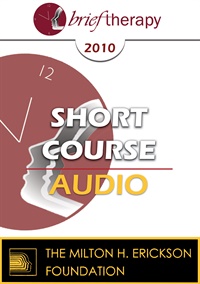
- Average Rating:
- Not yet rated
- Topic Areas:
- Addiction | Short Courses | Brief Therapy | Communication | Mind-Body | Utilization
- Categories:
- Brief Therapy Conference | Brief Therapy Conference 2010
- Faculty:
- Bart Walsh, MSW
- Duration:
- 1:32:27
- Format:
- Audio Only
- Original Program Date:
- Dec 09, 2010
- Short Description:
- This presentation poses a substance abuse treatment which acknowledges and accommodates the personal needs being addressed by substance use, bypasses perceived resistance and employs idiosyncratic psycho-biological learning to achieve a mind-body gestalt complementary to the client’s sobriety. Client self-empowerment and relapse prevention are built into the intervention. This method develops a safe framework for addressing any subsequent mental health themes directly or indirectly related to substance misuse. A simple form of mind-body communication known as ideomotor questioning is employed in this procedure. Because this is a new strategy, fundamental information applicable to all levels of professional experience will be provided.
- Price:
- $15.00 - Base Price
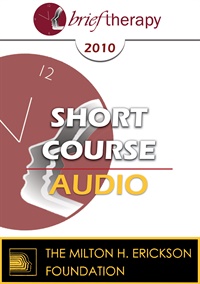
- Average Rating:
- Not yet rated
- Topic Areas:
- Hypnosis | Short Courses | Therapist Development | Brief Therapy | Supervision | Utilization
- Categories:
- Brief Therapy Conference | Brief Therapy Conference 2010
- Faculty:
- Dale Bertram, PhD | Mike Rankin, MA
- Duration:
- 1:19:17
- Format:
- Audio Only
- Original Program Date:
- Dec 09, 2010
- Short Description:
- By utilizing hypnosis in supervision, supervisors can help supervisees tap into their resources and grow in confidence as therapists. This process of utilizing hypnosis in supervision can be a useful method to meet the standards for achieving the results that supervisors, supervisees, and clients seek. This process can be a very effective method in achieving coherence, strengthening the ability to be accountable, while helping form a clear map for directing supervision.
- Price:
- $15.00 - Base Price
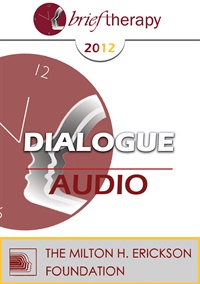
- Average Rating:
- Not yet rated
- Topic Areas:
- Dialogues | Utilization
- Categories:
- Brief Therapy Conference | Brief Therapy Conference 2012
- Faculty:
- Stephen Gilligan, PhD | Jeffrey Zeig, PhD
- Duration:
- 1:00:25
- Format:
- Audio Only
- Original Program Date:
- Dec 07, 2012
- Short Description:
- BT12 Dialogue 07 - Utilization: The Foundation of Solutions - Stephen Gilligan, PhD, Jeffrey Zeig, PhD Educational Objectives: Given a topic, describe the differing approaches to psychotherapy, and identify the strengths and weaknesses of each approach.
- Price:
- $15.00 - Base Price
- Average Rating:
- Not yet rated
- Topic Areas:
- Clinical Demonstrations | Utilization | Ericksonian Hypnosis and Therapy Techniques
- Categories:
- Brief Therapy Conference | Brief Therapy Conference 2014
- Faculty:
- Jeffrey Zeig, PhD
- Course Levels:
- Master Degree or Higher in Health-Related Field
- Duration:
- 55:39
- Format:
- Audio and Video
- Original Program Date:
- Dec 13, 2014
- Short Description:
- All of Milton Erickson’s cases are based in utilization. It is an “alchemical formula” of turning lead into gold. Utilization is not a technique; it is an orientation that the therapist assumes. Utilization is an orientation of sufficiency that is the opposite of psychological problems, which can be viewed as believed in insufficiencies.
- Price:
-
Sale is $29.00
price reduced from Base Price - $59.00
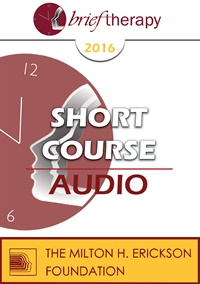
- Average Rating:
- Not yet rated
- Topic Areas:
- Short Courses | Metaphors | Utilization
- Categories:
- Brief Therapy Conference | Brief Therapy Conference 2016
- Faculty:
- Christine Guilloux, DESS Psychology
- Duration:
- 1:28:15
- Format:
- Audio Only
- Original Program Date:
- Dec 08, 2016
- Short Description:
- Among our models, our heroes, our genius and the stories that have been told to us, the ones we’ve built, the ones we’ve integrated, there are some that are deep metaphors within us. We will explore how we refer to them, how they structure and impact our lives and how we can utilize them in our therapeutic goals for inner change and help the patient build from the hero within himself/herself.
- Price:
- $15.00 - Base Price
Tags: Metaphors Utilization
- Average Rating:
- Not yet rated
- Topic Areas:
- Addiction | Short Courses | Utilization | Mind-Body
- Categories:
- Brief Therapy Conference | Brief Therapy Conference 2016
- Faculty:
- Bart Walsh, MSW
- Course Levels:
- Master Degree or Higher in Health-Related Field
- Duration:
- 1:30:02
- Format:
- Audio and Video
- Original Program Date:
- Dec 08, 2016
- Short Description:
- This presentation poses a substance abuse treatment which acknowledges and accommodates the personal needs being addressed by substance use, bypasses perceived resistance and employs idiosyncratic psycho-biological learning to achieve a body-mind gestalt complementary to the client’s sobriety. Client self empowerment and relapse prevention are built into the intervention This method develops a safe framework for addressing any subsequent mental health themes directly or indirectly related to substance misuse. Ideomotor questioning is employed as a practical conduit to body-mind communication and function.
- Price:
- $0.00 - $29.00
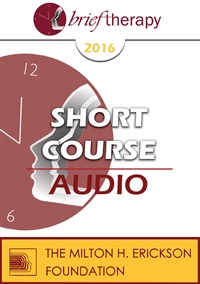
- Average Rating:
- Not yet rated
- Topic Areas:
- Couples Therapy | Short Courses | Brief Therapy | Experiential Therapy | Mind-Body | Psychotherapy | Utilization | Meditation, Spirituality and Yoga
- Categories:
- Brief Therapy Conference | Brief Therapy Conference 2016
- Faculty:
- Sheldon Kramer, PhD
- Duration:
- 1:29:47
- Format:
- Audio Only
- Original Program Date:
- Dec 08, 2016
- Short Description:
- Participants will learn powerful techniques to facilitate the integration of individual and couples therapy through meditation, guided imagery, and energy centers in the body. Beginning exploration will focus on the healing capacity found innately in the "Mind- Body Couples System" (Mind Body Systems Therapy( TM) through the use of intense affect to unify significant others through transforming fear, anger, and grief into understanding ,compassion, love, and forgiveness. The class will be both didactic and experiential.
- Price:
- $15.00 - Base Price
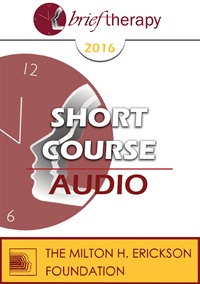
- Average Rating:
- Not yet rated
- Topic Areas:
- Short Courses | Utilization | Interviewing | Ericksonian Hypnosis and Therapy Techniques | Psychotherapy | Hypnosis
- Categories:
- Brief Therapy Conference | Brief Therapy Conference 2016
- Faculty:
- Brent Geary, PhD | Claudia Weinspach, Dipl. Psych
- Duration:
- 1:21:38
- Format:
- Audio Only
- Original Program Date:
- Dec 08, 2016
- Short Description:
- Milton Erickson’s counsel to “Take what the patient brings” encapsulated the utilization approach that he introduced in hypnosis and psychotherapy. This workshop is designed to enhance participants’ awareness of and ability to use the many facets of utilization that are elicited during clinical interviews. Two demonstrations will be included.
- Price:
- $15.00 - Base Price


